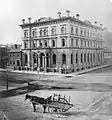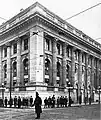 | |
| Industry | Banking |
|---|---|
| Founded | 1855 |
| Defunct | 1955 |
| Fate | Merged with The Dominion Bank to form TD Bank Group (Toronto-Dominion Bank) |
| Successor | TD Bank Group |
| Headquarters | Toronto, Ontario, Canada |
Key people | James Grant Chewett (first president) |
The Bank of Toronto was a Canadian bank that was founded in 1855 by a group of grain dealers and flour millers.[1] On February 1, 1955, it merged with The Dominion Bank to form the Toronto-Dominion Bank, which is now known as the present-day TD Bank Group. Its first president was James Grant Chewett, whose support was sought by financier Thomas Clarkson.
History
In July 1856, the Bank of Toronto opened its offices at 78 Church Street, Toronto, with a staff of three and immediately began development of a provincial network of branches. Thomas Clarkson, a major participant in the growing Toronto commerce, served as one of the first directors from 1856 through to 1858, steering the Bank through the depression of 1857.[2] In 1860, it opened its first branch outside of Ontario (then as Canada West), in Montreal, Canada East.
The Bank of Toronto established itself as an efficient, profitable, but essentially conservative bank through the 19th century. It maintained a very high reserve against its capital and enjoyed the highest share price of any bank in Canada. Growth was very slow and deliberate, with a few new branches opened in emerging regional centres. Core customers remained farmers, merchants, and processors of farm products (millers, brewers, distillers).
With the maturing of the Canadian economy and the opening of northern Ontario and the West in the 1880s and 1890s, the banks became more aggressive in loans to resource industries, utilities, and manufacturing. In 1899, the Bank of Toronto opened a branch in the British Columbia mining town of Rossland. In the first decade of the twentieth century, the banks rapidly expanded their branch networks in central Canada and across the west.
To mark their rise as significant national institutions, the Bank of Toronto moved into a large new head office building at the corner of King and Bay Streets in Toronto in 1913.
World War I brought new challenges for the two banks when they were called upon to finance war expenditures and to support the innovation of war bonds marketed to the general public. Half of the staff of the two banks served in the armed forces.

Except for some contraction in the western provinces due to drought, the decade following the war was one of expansion and increasing profitability due to resource development and industrial expansion. The bank weathered the storm of depression in the 1930s without great difficulty, despite a decline in earnings. Like all Canadian banks, they endured criticism of its credit policies and resisted the introduction of a central bank to control the money supply and advise on fiscal policy. Ultimately the Bank of Canada was established and the banks relinquished their right to issue their own currency.
The coming of the Second World War involved the banks, once again, in the marketing of war bonds and in participation in the control of foreign exchange, rationing, and other financial war measures. Approximately 500 staff, or almost half the total, entered the armed forces.
The Bank of Toronto emerged from the war in 1945 stronger than ever, with assets more than doubled since 1939. With the post-war boom they became more active in business lending and in the penetration of new markets. However, they quickly realized that the costs of expansion and competition with much larger rivals made their objectives difficult to realize. Neither bank had engaged in acquisitions or mergers in order to grow, but both determined that a union with a bank of equal size would place them in a much stronger position to take advantage of the opportunities of the post-war economy.
Architecture
The Bank of Toronto in Winnipeg, Manitoba erected in 1905-06 is on the Registry of Historical Places of Canada.[3] The Bank of Toronto at 205 Yonge Street in Toronto, Ontario built in 1905 is on the Registry of Historical Places of Canada.[4] The Bank of Toronto Building in Victoria, British Columbia built in 1951 is on the Registry of Historical Places of Canada.[5] The Bank of Toronto Building in Chaplin, Saskatchewan built in 1915 is on the Registry of Historical Places of Canada.[6] The Bank of Toronto Vault in Turtle Mountain, Manitoba, completed in 1919, is on the Registry of Historical Places of Canada.[7] Andrew Taylor designed the Bank of Toronto at St. James Street & McGill Street, which was erected in 1893-94.[8]
Amalgamation
In 1954, negotiations began between the Bank of Toronto and the Dominion Bank, and by the end of the year, an amalgamation agreement was reached. In their brief to the Minister of Finance, the banks stated: "It is more burdensome for a small bank to keep pace with the development of our country than for a large bank, with the result that the effective growth and comparative influence of smaller banks will probably in the future decline in comparison with that of the larger banks."
On November 1, 1954, Canada's minister of finance announced that the amalgamation was accepted and shareholders were asked for their approval. This was forthcoming in December and on February 1, 1955, the Bank of Toronto and the Dominion Bank became the Toronto-Dominion Bank.
The building at 78 Church Street was listed on the City of Toronto Heritage Property Inventory on August 14, 1991, in hopes of preserving some of its historical physical attributes.[9]
Gallery
 Bank of Toronto Head Office (Church and Wellington Streets, Toronto 1868) until 1915
Bank of Toronto Head Office (Church and Wellington Streets, Toronto 1868) until 1915 Bank of Toronto Head Office (Bay and King Streets, Toronto) 1915-1955
Bank of Toronto Head Office (Bay and King Streets, Toronto) 1915-1955 Bank of Toronto logo from 189_ cheque. Showing incorporation in 1855.
Bank of Toronto logo from 189_ cheque. Showing incorporation in 1855.
See also
References
- ↑ "TD Bank Financial Group. Celebrating a rich history". Archived from the original on 8 May 2006. Retrieved June 2, 2006.
- ↑ "Biography – CLARKSON, THOMAS – Volume X (1871-1880) – Dictionary of Canadian Biography". www.biographi.ca.
- ↑ "Bank of Toronto". HistoricPlaces.ca. Retrieved 2019-04-26.
- ↑ "Bank of Toronto, 205 Yonge Street". HistoricPlaces.ca. Retrieved 2019-04-26.
- ↑ "Bank of Toronto". HistoricPlaces.ca. Retrieved 2019-04-26.
- ↑ "Bank of Toronto Building, 414 4th Street, Chaplin, Saskatchewan". HistoricPlaces.ca. Retrieved 2019-04-26.
- ↑ "Bank of Toronto Vault, Turtle Mountain, Manitoba". HistoricPlaces.ca.
- ↑ "Andrew Taylor". Biographic Dictionary of Architects in Canada 1800-1950. Archived from the original on 2015-02-03. Retrieved 2019-04-26.
- ↑ "City of Toronto's Heritage Property Search Detail for 78 Church Street". City of Toronto.
- "The Distillery Historic District". Archived from the original on 15 November 2010. Retrieved November 20, 2010.
- "The Bank of Toronto 1857 Annual Report (PDF)" (PDF). Archived from the original (PDF) on May 15, 2011. Retrieved February 21, 2006.
- R. J. Graham `Canadian Bank Notes 6th Edition: A Charlton Standard Catalogue` Charlton Press July 17, 2008
External links
 Media related to Bank of Toronto at Wikimedia Commons
Media related to Bank of Toronto at Wikimedia Commons- The Bank of Toronto's Annual Reports at the McGill Digital Archive